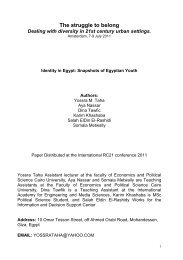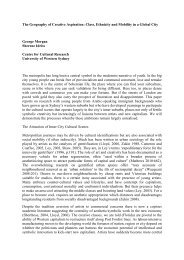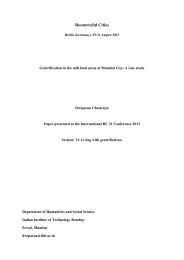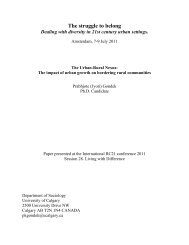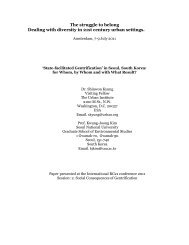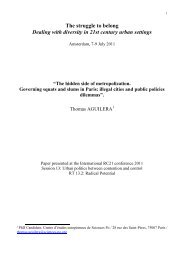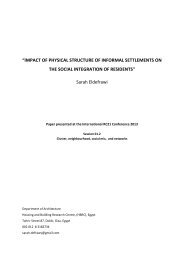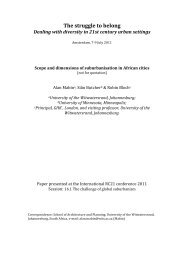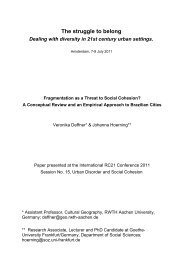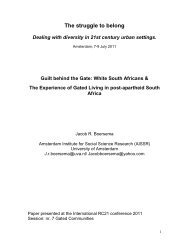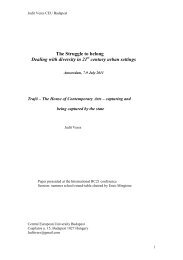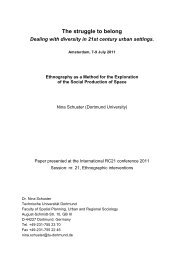IMMIGRANT STREET TRADERS IN SOUTH AFRICA - RC21 ORG ...
IMMIGRANT STREET TRADERS IN SOUTH AFRICA - RC21 ORG ...
IMMIGRANT STREET TRADERS IN SOUTH AFRICA - RC21 ORG ...
You also want an ePaper? Increase the reach of your titles
YUMPU automatically turns print PDFs into web optimized ePapers that Google loves.
<strong>IMMIGRANT</strong> <strong>STREET</strong> <strong>TRADERS</strong> <strong>IN</strong> <strong>SOUTH</strong> <strong>AFRICA</strong>:The economics, the struggle and the tensions.Author:Institution:Address:E-mail:Telephone:Christal Mudi-OkoroduduUniversity of HelsinkiTilanhoitajankaari 3c 44, Helsinki, FinlandChristal.mudi-okorodudu@helsinki.fi358 44 2197811
ABSTRACT„People say there is a struggle for resources going on between South Africans andforeigners‟, actually the struggle is long over. The foreigners have won hands down.‟(interviewee in Johannesburg, as quoted in Steinberg J. 2008, pg6)Street trading has been successfully entrenched in urban cities in developing countries inAfrica due to the attractiveness of „convenience, affordability and personalized servicesfrom known vendors. Thus the proliferation of street trading in big urban cities cannot allbe attributed to „push factors‟ like ease of entry and unemployment but also to „pullfactors‟ like availability of buyers and personal relationships building. Thus, Iconceptualize immigrant street trade as the meeting point of the immigrants‟ struggle forsocial and economic emancipation and the locals struggle for economic realization. Fromthis meeting point, could develop social conflict, negotiations and adaptations thatpossibly will lead to communal cooperation or disintegration. In the case of South Africa,this has recently resulted in violent disintegration in form of xenophobic violence in2008. Presently, the community of immigrant street traders and their host, havepresumably returned to „normal life‟ with veiled tensions.Using lifestory methodology and supported with participant observation, I will seek toexplore the nodal points of contacts between the immigrants and their host communitybased on their economic activity (street trade). My study will focus on the immigrantsstories, roles and conceptions. I cannot access the local South Africans for this qualitativestudy due to language barriers and social tensions. However, I will draw from previousstudies of local South Africans in townships and from personal observations. I will usethe Nigerians and Congolese immigrant street traders as case study of the research.2
unfriendly and harsh socio-political migrant context, they have very limited access tostate support. Yet the immigrants consider themselves „the winner of the struggle forresources‟. Their image of a „winner‟ strongly contradicts the commonly accepted andunderstood view of the street trader as „victims‟ engaged in highly unprofitable economicactivity. This highlights the view that the gloomy representation of immigrant streettraders as urban underclass falls short of „what is really happening‟ (see Rath, 2000).This research will contribute to previous studies by conceptualizing street traders as„winners in the struggle for resources‟. That is, as creative and resourceful actors, thatactively engages their challenging context to achieve economic freedom. Previous studieson immigrant street traders have often emphasized the one sided social networks of theimmigrants, that are appropriated for entrepreneurial gains. However, the growingsuccess of immigrant businesses in advanced countries and their ties to the economy ofsuch countries have suggested a relationship of interdependence (see Rath, 2000).Although situated at the lowest rung of the informal sector, this can also be applied to thestreet traders. Beyond the poverty and environmental hazard, at the heart of street trading,lie the interactions and transactions of social relationship.To explore the dynamics of this process in the context of the study, the research willanalyze immigrants‟ street trade as means of facilitation (social relationship), generation(income), and consumption (local resources). It will adopt resilience theory as a guide toexamine how immigrant street traders interact with their environment to overcomeimpediments to running their business. To explore its points, it will take street trade asthe focal point of contact between the local community and authority. Thus, it willdiscuss and explore the activities and experience of the immigrants that relates to theestablishment of the street trade and its continuous operations. It looks at each point ofcontact between the immigrants and their host, examining the strategies to deter orfacilitate the start, death or continuity of the street trade.The study will focus on two immigrant groups in the city of Cape Town, South Africa –the Congolese and Nigerians. It is necessary to adopt two different immigrant groups for4
this study to de-emphasize ethnicity and highlight the interactive dynamics betweenimmigrants and host community. However, ethnicity will be explored as a factor iffound to be relevant (due to the South African context) in the course of data analysis.Furthermore, the immigrant groups selected represent members from the SouthernAfrican Development Community (SADC) and outside the SADC. Thus if the dataindicates regional affiliation as relevant, there will be opportunity for comparison ofexperience. The immigrant groups are selected for ease of accessibility andcommunication.2. BACKGROUND„People say there is a struggle for resources going on between South Africans and foreigners.Actually the struggle is long over. The foreigners have won hands down.‟ (A senior Johannesburgbureaucrat interviewee, as quoted in Steinberg. 2008, pg6)Few days after the eruption of xenophobic violence in May, 2008, in South Africa, JonnySteinberg 2 under the auspices of the Institute for Security Studies 3 conducted a field studyon the violence in some of the worst affected areas. This study (Steinberg, J., 2008) isquite relevant because it was done few days 4after the riots and most importantly itfocused on the accounts and tales of the victims and the perpetrators. This gave a vividrepresentation of the voices of the victims and the perpetrators of the violence. Twocrucial points that could be gleaned from the views of the interviewees are, firstly, thatlocal South Africans believe that other African nationals (as foreigners) are grabbingSouth Africa‟s wealth and transferring it to their countries of origin. The emphasis here isto „grab‟ and „transfer‟. This view is quite common and have earlier (before thexenophobic riots) been expressed by other South Africans in their response to the influxof immigrants into South Africa immediately after the apartheid era.2 Jonny Steinberg is a author and researcher that has written extensively on issues of criminal justice,security and other social issues challenging the new democratic and fragile nationhood of South Africa. Hewas educated in Wits (South Africa) and at Oxford University.3 The Institute for Security Studies (ISS) is a leading African human security research institute based inSouth Africa. It pursues a vision of a stable and peaceful Africa through its activities. Detailed informationabout its activities can be found in www.iss.co.za.4 The xenophobic riots occurred between 11 th and 26 th May, 2008. Steinberg conducted his field studybetween 1 st and 10 th June, 2008.5
“if South Africans are going to compete for scarce resources with the millions of „aliens‟ that arepouring into South Africa, then we can bid goodbye to our Reconstruction and DevelopmentProgramme” (Minister of Home Affairs, 1994, as reported in Palmary, I. 2002, pg. 4).The relevance of this view to this research is how the immigrant street traders experienceit in their everyday life, with focus on how this is experienced in the entrepreneurialactivities of the immigrant street traders.The second critical point is that the immigrants consider themselves as winners over thebarriers and adversities that inundated their operating environment. Their views imply apeople that have confronted their adverse context by perseverance and tactics, and havereaped economic gains as their reward. Their story emphasizes an active interaction withthe wider environment of their host. This evokes pictures of active and dynamicimmigrant entrepreneurs in an adverse and unyielding context.“To be selling fresh vegetables by seven in the morning, I must start making my way to the freshproduce market in City Deep at 3am. I can say that there is not a single South African awake atthat time. The people on the street preparing for work are foreigners, every last one of them…”(an immigrant interviewee as reported in Steinberg J. 2008, pg. 7)“We arrived in this country without tools. At first we accepted any job… As we worked, so wesaved. We bought tools. Business picked up. We charged more. As we gained success, so webought television… and other nice things… From their point of view, what they saw wasforeigners coming to do work they refused to do and then buying things they could not afford”(immigrant interviewee, ibid.)This image of the immigrant as a dynamic agent that engages its host communitynotwithstanding the forms of exclusion and persecution illustrates resilience. Importantly,how this dynamism is translated into daily action that is motivated by the will to survive.Furthermore, the image of the immigrant as a „self made‟ „success‟ may suggest thatalthough the immigrants interact and engage with the environment, yet there is a lack of6
interdependence or a perception of lack of interdependence. That is, the immigrant streettrader does not perceive or acknowledge the contribution of their host society to theirentrepreneurial gains. The understanding of how this perception is translated into thedaily activities of the immigrant entrepreneur could be relevant for intervention policytargeting xenophobic feelings.2.1 <strong>SOUTH</strong> <strong>AFRICA</strong>: In the shadow of apartheidAlthough the apartheid regime in South Africa ended over ten years ago, the effects of itsills and wrongs continue to live on. Though care must be taken not to attribute everysocial ills or economic woes to the scourge of apartheid, yet, the reality as experienced inSouth Africa today cannot be divulged from the reign of apartheid in its history. In thissense, to understand South African‟s hatred and intolerance of immigrants (with specialfocus on other Africans), it is imperative to have a sound grasp of the apartheid regime.In this vein, but without going into details, it is important to highlight two importantaspects of the apartheid regime.Firstly, apartheid in South Africa was explicit and blatant. It was a system in which thestate classified racial hierarchy that determines the permitted quality of life; with theblacks located at the lowest rung. Indeed, the South Africa apartheid government was thefirst capitalist state to systematically and openly structure inequality (see Crush andPendleton, 2004; Seekings and Nattrass, 2006). During these years of apartheid, SouthAfrica was naturally not attractive as a migrant‟s destination, especially to other Africannationals. Not only did the deplorable economic, social and political situation for blacksin South Africa acted as deterrent to other African migrants, but also, the apartheidgovernment enforced strict controls over migrations in and out of South Africa. Theeffect was that, local South Africans did not have sustained social contacts with otherAfrica nationals during the difficult days of apartheid. Other Africa nationals werepermitted into South Africa as contract workers and only permitted to remain in SouthAfrica for short periods by the apartheid government. Thus Africa migrants visited SouthAfrica, to work, reap financial gains and transfer the gains to their country of origin. So7
this is the pattern that local South Africans can identify with other Africa migrants.Therefore, it is not surprising that the local South Africans do not have affinity with otherAfricans. The other African migrant economic activities cannot be related to thedevelopment of South Africa. So they cannot be permitted to reap the reward of postapartheid years when they were not in the midst of the struggle.On the other hand, majority of other Africa countries participated in the fight againstapartheid both at governmental as individual level. From personal experience, thestruggle against apartheid at the micro (individual) level was quite active and pervasive inNigeria. Local activists went around schools, markets, offices, churches etc, to speakagainst apartheid and solicit financial contributions from individuals to send to SouthAfrica. Popular musicians sang about and against apartheid in South Africa, thus evenchildren and the old were quite conversant with the struggle against apartheid andmajority made financial contributions towards the end of apartheid (see Morris, 1998).The strongest and reoccurring theme in this external struggle against apartheid was unity.As we are all Africans, South Africans are our brothers and sisters, and what hurts otherAfricans (our brothers and sisters), surely is our pain. However, most probably and as isoften the case, the local South Africans did not know about the local foreign „donors‟ ofthe funds that were utilized as part of the resources for the struggle against apartheid.Therefore, while other Africans felt they were part of the positive developments in SouthAfrica, and expected to be welcomed to South Africa with feelings of brotherliness, thelocal South Africans can only feel hostility, towards a people that were not around duringtheir hard times, but have come to reap from the harvest.Secondly, the goal and motive for the overthrow of apartheid, was anchored on thepremise of an overthrow of inequality and the delivery of better living standards by thedemocratic black government. Thus in 1994, when the blacks led democratic governmentwas sworn into office, it had a clear public commitment to correct the inequalities thathad been entrenched in the apartheid system (see Seekings and Nattrass, 2006). Also, theexpectations of the local South Africans were clear; they wanted economic and socialempowerment. Naturally, they expected the acquisition of political power by the blacks8
to be the tool needed to achieve the goals of economic and social empowerment,especially through distribution and redistribution. This is a natural expectation because itwas the usurping of political power by the white minority that was used to lock them in astate of economic and social penury. At the time of power handover in 1994, there wasnothing to suggest contrary to the popular expectations and believes.However, the present reality belies the expectations of local South Africans at the end ofapartheid. Inequality and poverty is still rife within South Africa, the government has notbeen able to deliver all their promises. Several reasons have been given for this currentstate of affairs in South Africa, but relevant to this study, is the view that was discussedby Moeletsi Mbeki 5 . Based on the enthusiasm to fill the socio-economic gaps caused byapartheid and in part by the zeal to meet the expectations of South Africans, the blackpolitical elites took a bureaucratic and distributive path to nationhood rather than adevelopmental path. Thus the black government focused on redistributing the wealth ofthe country through welfare packages and other related socio-economic policies (e.g.Black Economic Empowerment [BEE] program). So rather than creating wealth, thegovernment focused on consuming wealth through redistribution. While this had theadvantage of meeting the immediate needs of the people, it had several drawbacks withdebilitating effects on a globalizing economy.Some of the drawbacks relevant for this study includes: increase in unemployment, due topoor job creation, development of partisan politics – that is, the ruling political partydistributes the wealth of the country based on party loyalty, and the people also expectfinancial gratification and reward based on their party affiliation. This is an ill, Mbeki hasoften highlighted in his opposition of Thabo Mbeki, pointing out that “… majorbeneficiaries of large equity transfers are all individuals connected to the ANC… what isbeing traded is political influence” (see Steinberg J., 2008, pg. 10). One of the outcomes5 Moeletsi Mbeki is the brother of Thabo Mbeki, the second post-apartheid president of South Africa (1999– 2008). Moeletsi is a political economist and the deputy chairman of the South Africa Institute ofInternational Affair. He has written many articles about the political and economic situation in SouthAfrica. (See „The Curse of South Africa‟, in New statesman, 17 January, 2008; „A growing gap betweenthe black elite and the masses? Elites and political and economic change in South Africa since the Anglo –Boer war‟, in Vrye Afrikaan)9
of the mentioned drawbacks is how it affects South Africans‟ perception of their state.Local South Africans perceive other Africans as usurpers of the resources of their state.Even amongst the local South Africans, there are constant struggles for state patronage.As Steinberg (ibid) observed, local South Africans perceive their economy as a staticlump from which the politicians distribute wealth, each financial gains made by aforeigner, is a part of the lump lost to South Africans. This implies that the local SouthAfrican lives with the fear of the foreigner stealing their resources until it is completelyconsumed without being distributed to all South Africans. Naturally, living in a state ofpoverty and unemployment in the context of a distributive government, this fear caninfluence violence and other actions to deter the foreigners from achieving economicviability.However, the South African government has responded to tackle the level of poverty inthe townships, through various forms of social welfare grants for the poor andunemployed. In this vein the right to social security was entrenched in the constitution(S27 (1) C) (see Haarmann, 2001). Examples of the social welfare grants include: ChildSupport Grant, Social Old Age Pension, Disability Grant, Care dependency grants. Alsothe Unemployment Insurance Fund theoretically covers all the unemployed poor. SouthAfrica welfare transfers are based on means testing, making it theoretically probable thatthe transfers get to the poor (Pauw and Mncube, 2007). Nonetheless, the welfareintervention by the government has also been identified as part of the problem by theimmigrant street traders. They have argued that because of the numerous grants that areprovided by the government the South African poor are not motivated to engage in thehard work required by a thriving street trade business (see Morris, 1998; Steinberg,2006).10
2.2 MIGRATION TO <strong>SOUTH</strong> <strong>AFRICA</strong>: Xenophobia in the face ofglobalizationIt is true that despite the numerous problems that face the majority of Blacks in South Africa, forAfricans from other parts of the continent, the country is perceived as being the land of increasedeconomic opportunities and hope, especially after the 1994 elections… Hence, as long as thewidespread poverty and high levels of inequality prevail on the continent, South Africa willcontinue to attract migrants… (Maharaj, 2004. pg 2)As have been explicitly put by Maharaj above, post-apartheid South Africa is highlyattractive to other Africans from countries suffering from various forms of macroeconomicdeficiencies and violent conflicts. For the South African economy is one of thelargest and richest in Africa. It is rich in natural and mineral resources and is mainlyconsidered as reasonably industrialized (see Baden et al 1997). Thus South Africa hasregistered a huge influx of African migrants since the end of apartheid (see Crush andWilliams, 2001), for economic reasons. Yet economic reasons alone does not account forthe high influx of African immigrants into South Africa. Another reason that have pushedhuge numbers of African immigrants into South Africa is the ravage of war in severalcountries in Africa, but especially in Southern and Eastern Africa Countries, for example,Zimbabwe, Congo, Uganda, etc. Technically, immigrants from war torn countries haverefugee status, but are active in economic activities especially in the informal sector.In order to deal with its influx of migrants, the South Africa government has madeattempts to review and „improve‟ its policy on immigration since the end of apartheid. Tothis end the government has been signatory to several declarations of the rights andtreatment of immigrants, especially immigrants with refugee status. For example, in 1993the South African government signed a memorandum of understanding with the UnitedNations High Commissioner for Refugees (UNHCR) for safe passage of refugees intoSouth Africa. Nevertheless, as previously stated, the immigration policy of South Africahas been strongly criticized as giving inadequate attention to the rights of refugees andother foreigners. For example, asylum seekers may not seek or take up employmentpending the outcome of their application. While in reality, the processing of theapplication can take up to six months and above, yet the government does not provide for11
the needs of the asylum seekers. Such inconsistencies in the immigration policy of SouthAfrica still suggest the pursuit of „restrictionist‟ policy to actively discourage migration.Also, the inconsistencies make implementation of the policy by local government andother government agencies challenging, giving room for corrupt and hostile practicesagainst the asylum seekers. Notably, exclusionary and xenophobic attitudes are reportedas specially focused on black African immigrants (see Crush and Williams, 2001;Peberdy and Rogerson, 2000; Palmary, 2002).The immigration policy is critical to the survival and success of the immigrants‟ streettrade in several ways. Firstly the type of residence permit will either allow or prevent animmigrant from starting an enterprise (in this case street trade). Secondly, due to thesurvivalist nature of street trading, the socio economic welfare of a street trader is relatedto the accessibility of economic infrastructure and support services to the immigrants.Although South Africa constitution allows that everyone (resident in South Africa)should be entitled to social security, the system excludes non-citizens (see Pauw andMncube, 2007). Yet, it can be assumed that the absence of state support has facilitated thecreativity and dexterity of the immigrants in surmounting the challenges and obstaclescreated by the exclusion. The actions and activities to surmount the challenges willrequire the immigrant street traders to contact, interact and negotiate with the localauthorities to protect their interest and promote their business. Possibly, the same need tosurmount those challenges, will also spur the street traders to contact, interact andnegotiate with fellow street traders to appropriate the advantages of group action.Nevertheless, high numbers of the African immigrants in South Africa are assumed to beillegal immigrants, thus not legally entitled to state support and resources. Theassumptions are based on the knowledge that South Africa borders are highly porous andinefficiently controlled. Also, politicians are found of bandying very large figures ofillegal immigrants in South Africa for political motives; like transferring the blame ofunemployment, poverty and slow economic development to the presence of illegalimmigrants. Thus the perception of very high number of illegal immigrants, combined12
with the view that they are not contributing to the development of South Africa, fuelshostility and intolerance.The high level of hostilities, intolerance and the pursuit of restrictive immigrationcontradicts South Africa other regional pursuit, for example, trade with other Africannations. Regional cooperation like the SADC encourages and promotes economicrelationship between nations under its agreements. There are South African companiesthat have taken advantage of such agreements to establish branches in other Africancountries. Although most of these companies are big corporations, yet their existence andsuccesses in the other African countries are based on goodwill and legal agreements.Thus while South Africa is trying to improve its trade with other African nations, it isimportant that it deals with the hostilities and intolerance of African migrants amongst itspeople. One way to deal with the hostilities and intolerance is to promote social cohesionand highlight interdependence. In this vein, street trading is relevant because of the largenumber of immigrants that engage in it and its operations demands a high level ofinteraction between the immigrants and their host community.This is commensurate with studies on entrepreneurship that has highlighted its dynamicform, especially as “a social and economic behavior in which people respond toenvironmental signals about the availability of opportunities and the resources withwhich they can be exploited” (see Rae and Carswell, 2000, pg 220). In the process ofstarting and sustaining a street trading business, the immigrant street trader is compelledto deal with the locals as customers of their business, as suppliers of their products, asemployers, as competitors/business neighbors and as local authorities. In each of thesecontact points the immigrant street trader is engaged in some form of social andeconomic transaction and negotiation.In this vein, as the immigrant street trader encounters and overcomes hardship in the formof obstacles or challenges to effectively run the street trading business, the trader isdeveloping resilience strategies or appropriating already existing strategies. It is therelationship between these strategies and the welfare (social and economic) of the13
immigrant that contributes to the conception of the immigrant self as a „winner‟. Indeed,the capability to survive and possibly grow amidst their challenges, suggests creativityand innovativeness in the practice of the business. Within this context, street trading bythe immigrants can be seen as means of social conduit between the immigrants andlocals, which is being facilitated by the economic transactions of the trade. Socialperception, feelings and messages are being formed, strengthened, countered andtransmitted at each point of contact in the course of business activities. The effect of thisconduit creates a form of interdependence between the immigrant street traders, the localsand local authorities.3. THEORETICAL GUIDETo the observer of the immigrant street trader the harshness of the trade, the meagerproducts and the trickle of income leads to questions such as „how do they manage?‟ and„why do they continue?‟, „There can be no hope in this or can there?‟. The life ofhardship in a challenging context requires that the participants of that life make attemptsto manage the challenges and strengthen their chance to survive. The attempt to managethe challenges could either be in the form of pre-planned strategies or unplanned actions.In this sense, the relationship between the participants and the context is highly dynamicand goal directed. With this background, in order to capture the dynamism and effects ofthe subject matter of this study, I have chosen to adopt resilience theory as a guide. In thesame context it is my hope that the study will also contribute to the development of theresilience theory.The theoretical construct of resilience denotes two important conditions: exposure to highrisk or vulnerable situation and the ability to achieve success and adapt positively (seeLuthar et al, 2000). However, the definition of each of the constructs has been the sourceof ongoing criticisms and growing concerns about its scientific value (see Kaplan, 1999;Luthar and Cushing, 1999; Tarter and Vanykov, 1999). One of the major criticisms is thecontention that the resilience construct adds nothing significant to the more general term14
of „positive adjustment‟ thus inferring that it is not relevant to define resilience as aseparate term (Tarter and Vanyukov, 1999; Kaplan, 1999; Tolan, 1996). However,studies have shown empirical evidence that systems may achieve resilience or positiveadaptation through different ways. More so, the presence of adversity or vulnerability isnot necessary for the system to achieve positive adaptation. These infer that resilienceand positive adaptation can represent different constructs (see Luthar et al, 2000).Nevertheless, there has been criticism about the inconsistencies and ambiguity in the keyconstructs of resilience (see Cicchetti and Garmezy, 1993; Luthar and Cushing, 1999;Tarter and Vanyukov, 1999), prompting Luther et al to advice that in the absence ofuniversally employed operationalization, researchers should state clearly the approachadopted for their study. Furthermore, it is also imperative that researchers indicate if theirstudy conceptualizes resilience as a dynamic process or else as a psychological trait.Although this research does not focus on studying „what is resilience‟, but by utilizing theresilience theory as a guide, it creates the possibility of contributing to the ongoingdiscussion of the „what‟, „how‟ and „where‟ of resilience. In this vein, resilience isconceptualized in this study as a dynamic process of interaction between the individualand its environment (see Masten et al, 1999, Ruttter, 1993). Also this study will departfrom the theoretical definitions of pivotal terms in resilience theory by adopting acontextual definition given by participants in the study. That is, central terms such as„vulnerability‟, „risk‟, and „positive adaptation‟ in the resilience construct will assume themeanings as experienced and defined by the participants in the context of the study. Thisapproach will give the research the advantage of bypassing the ongoing argument aboutinconsistencies in the definition of the concepts (see Luthar and Cushing, 1999; Luthar etal, 2000). Also, this will ground the study in its context, creating the avenue for newdimensions and perspectives to emerge that will contribute to our understanding ofresilience.Furthermore the research will adopt the definition of resilience as “the ability of a systemto remain functionally stable in the face of stress and to recover following a disturbance”(Redman and Kinzig, 2003. Pg.5). That is, theoretically emphasizing the flexibility and15
adaptiveness of a system. This implies that the more flexible a system is, the better it canadapt, and the more resilient it becomes (Levin, 1999). Furthermore, a resilienceapproach implies an active system in all phases towards the goal of stability, emphasizingthe dynamic nature of resilience, risk and vulnerability (see Luther, 1996; Masten, 1994).Thus a resilience approach affords the opportunity to study the socio-economic activitiesof the immigrant street traders both as a response to and a product of the challengingcontext, with focus on the dynamism of the actors in response to their wider environment.In this vein, this research hypothesizes that the immigrant street traders can take moreactive responsibility for social cohesion in the local community, than is traditionallyexpected. Also, that within the context of street trading, efforts towards cooperation andintegration of the immigrant street traders should pursue the goals of flexibility andadaptation rather than control and structure that is more common with local authorities.3.1 A RESILIENCE APPROACHAt the core of the resilience approach is the assumption that the immigrant street trader isbeing motivated by the pressing need for survival in a harsh and aggressive environment.That is, the environment is not passive but active in its actions and reactions to deter theentrepreneurial drive of the immigrant street trader. Thus the onus lies with the immigrantstreet trader to take actions to tackle the barriers and challenges and establish an optimalsystem of performance for their business. The pressing need for survival is compelled bythe uncertainty, risk, and vulnerability traditionally associated with the role of a foreignerand a street trader. The reason for living as a foreigner is often equated with capitalistcompulsions or constraints of violence and persecution from home (see Beck, 2004;Malcomson, 1998). This relates to the immigrant street trader in the South Africancontext. As have been discussed above, African immigrants that populate street trading inSouth Africa are being pushed from home by either war and violence or economichardship from their country of origin (see Steinberg, 2005; Morris, 1998). Thus in talkingabout their life story as immigrants and street trader in the South Africa context, theimmigrant street traders will define their conception of risk, vulnerability and adaptation.16
So, arriving in South Africa in a state of vulnerability and poverty, the immigrant relieson ties, skills or structural opportunities that can be leveraged for economic gains. In thissense, most studies have focused on the support of ethnic network as the social capital ofthe immigrant. That is, the immigrant is admitted into an existing network based onethnic affiliations and thus, can appropriate existing benefits for material gains. However,to acquire entrepreneurship gains, the immigrant will need to develop ties with GeorgSimmel‟s (1971) „outsiders‟ or what is more recently conceptualized as „bridge socialcapital‟ (see Woolcock and Narayan, 2000).Furthermore, although a resilience theory assumes that a system is resilient when itabsorbs high level of shock without losing its core, the social world is highlycharacterized by flexibility, relativity and dynamism, thus the core of resilience in asocial dynamics will not be its regularity but how it changes its form to adapt to shocks.The response of the entrepreneurial activities of the immigrant street traders to the shockof the xenophobic violence of 2008 may give an interesting view of social resilience.4. RESEARCH OBJECTIVEThe research objective is to learn how immigrant street traders successfully operate theirbusiness, using point of contacts with locals as a platform of interaction andinterdependence. It explores how street trade can be harnessed as a means of cooperationand integration, but could also instigate disintegration. To achieve cooperation andcohesion it is critical that the interdependence and interrelationship of the goals of allparties be emphasized and highlighted.The research aims at providing answer to the following questions:1. How do immigrants successfully operate street trading business in South Africadrawing from the wider environment of their host?17
2. Did the xenophobic violence of 2008 have any effect on the entrepreneurialactivities of the immigrant street traders5. RESEARCH METHODThis is a qualitative study with possibility for quantitative analysis at the end. It willutilize multi methods to achieve its objectives. Basically, a life-story approach (Atkinson,1998; Roberts, 2002) will be followed for insights into how the different social changes(the peak being the xenophobic violent eruption) and experiences are interpreted andeconomically acted upon. This approach will give me the opportunity to explore ininterpretive ways, the experiences and actions of the immigrant street traders asunderstood in the present settings. In this sense, semi structured in-depth interview willbe conducted with selected participants. The aim is to prompt participants to reflect upon,and disclose their „life story‟ from arrival to present day. The focus will be on theirinteraction and actions with South Africans as it relates to starting and sustaining theirstreet trade.Also, participant observation will support data from interviews and discussions. That is,the study will benefit from a mid to long term observation of the immigrants in theirplace of street trade and as they go about the daily business activities (for example,meeting with supplier or local government officials).Furthermore, there is the need to support field data with a study of relevant Newspapers,articles and reports that discuss the views of local South Africans on the immigrant streettraders. This method is necessary in order to get a representative view of the SouthAfricans in the analysis of the data.RESEARCH OUTPUTAt the end of my research, I expect to have produced three or four published articles.18
BIBLIOGRAPHYAdepoju, A., 2003. „Continuity and changing configurations of migration to and from therepublic of South Africa‟. International Migration, Vol 4 (1)Arango, J., 2000. „Explaining migration: a critical view‟. UNESCO. Blackwellpublishers, UKAtkinson, R. 1998. „The Life Story Interview‟, Sage, Newbury Park, CA.Beck,U. 2004. „Cosmopolitical realism: on the distinction between consmopolitanism inphilosophy and the social sciences‟. Global Networks 4, 2, pg. 131-156.Cicchetti, D. and Garmezy, N., 1993. „Prospects and promises in the study of resilience‟.Development and Psychopathology, 5, 497 - 502Cox, K, R,. 2004. „Urbanization in South Africa and the changing character of migrantlabour‟ South African Geographical Journal 86:1, 7-16.Crush, J. and Williams, V. 2001. „Making up the numbers: Measuring “illegalimmigration” to South Africa‟. Migration Policy Brief, 3. Southern African MigrationProject.Crush, J., and Williams, V. 2001. „The New South African Immigration Bill: A legalanalysis‟. The Southern African Migration Project. Migration Policy Series No. 2. CapeTown, Idasa.Crush J. and Pendleton W. 2004. „Regionalizing Xenophobia? Citizens attitude toimmigration and refugee policy in Southern Africa.‟ The Southern African MigrationProject.Curtis, W. J. and Cicchetti, D. 2003. „Moving research on resilience into the 21 st century:Theoretical and methodological considerations in examining the biological contributorsto resilience‟. Development and Psychopathology, 15, pg. 773 – 810.Haarmann, C., 2001. „Poverty and Current Social Assistance Programmes in SouthAfrica‟. University of Cape Town, South Africa.Hunter, N., and Skinner, C., 2003. „Foreign Street Traders Working in Inner City Durban:Local Government Policy Challenges‟. Urban Forum, Vol. 14, (4), October-December.19
Kaplan, H. B., 1999. „Toward an understanding of resilience: A critical review ofdefinitions and models‟. In Resilience and development: Positive life adaptations, Glantz,M.D. and Johnson, J. L. (Eds). New York, Plenum Press (pg. 17 – 83).Levin, S. A. 1999. „Fragile dominion: Complexity and the commons‟. Perseus Books,Reading, Massachusetts, USA.Luthar, S. S., Cicchetti D., Becker B., 2000. „The construct of resilience: A criticalevaluation and guidelines for future work‟. Child Development, May/June, Volume 71,Number 3, pg. 543-562Luthar, S.S., Cicchetti D., and Becker B. 2000. „The Construct of Resilience: A criticalEvaluation and Guidelines for Future Work‟. Child Development, May/June, Vol. 71,Number 3, pg. 543 – 562Luthar, S. S., and Cushing, G., 1999. „Measurement issues in the empirical study ofresilience: An overview‟. In Resilience and Development: Positive life adaptations,Glantz, M.D. and Johnson, J. L., (Eds). Plenum, New York.Luthar, S. S., 1996. „Resilience: A construct of value? Paper presented at the 104 thAnnual Convention of the American Psychological Association, Toronto.Maharaj, B., 2004. „Immigration to post-apartheid South Africa‟. Global MigrationPerspectives, No. 1 (June). Global Commission on International Migration, SwitzerlandMalcomson, S.L., 1998. „The varieties of cosmopolitan experience‟. In Cosmopolitics:thinking and feeling beyond the nation, Cheah P., and Robins, B. (Eds). University pressof Minnesota, Minnesota. Pg. 233 – 245.Marschke, M. J. and Berkes, F. „Exploring Strategies that Build Livelihood Resilience: acase from Cambodia‟. Ecology and Society 11 (1): 42Masade, I., 2007. „Where is home? Transnational migration and identity amongstNigerians in Cape Town‟. In Imagining the city: Memories and cultures in Cape Town,Field S., Meyer R., Swanson F. (Eds). HSRC press, Cape Town, South Africa.Masten, A. S., 1994. „Resilience in individual development: Successful adaptationdespite risk and adversity‟. In Educational resilience in inner-city America: Challengesand prospects, M.C. Wang & E.W. Gordon (Eds), (pg 3-25). Hillsdale, NJ: Erlbaum.Masten, A. S., Hubbard, J. J., Gest, S. D., Tellegen, A., Garmezy, N., and Ramirez, M.1999. „Competence in the context of adversity: Pathways to resilience and maladaptationfrom childhood to late adolescence‟. Development and Psychopathology, 11, 143 – 169.20
Morris, A., 1998, „Our fellow Africans make our lives hell: the lives of Congolese andNigerians living in Johannesburg‟. Ethnic and Racial Studies, 21: 6, 1116 – 1136.Palmary, I., 2002. „Refugees, Safety and Xenophobia in South African Cities: The role oflocal government‟. Centre for the study of violence and reconciliation.Pauw, K., and Mncube, L., 2007. „Expanding the Social Security Net in South Africa:Opportunities, Challenges and Constraints‟. International Poverty Centre, Brazil. CountryStudy, No. 8. (July).Peberdy, S. and Rogerson, C. 2000. „Transnationalism and Non-South AfricanEntrepreneurs in South Africa's Small, Medium and Micro-Enterprise (SMME)‟Canadian Journal of African Studies / Revue Canadienne des Études Africaines, Vol.34,(1)Rae, D. and Carswell, M. 2000. „Using a life-story approach in researchingentrepreneurial learning: the development of a conceptual model and its implications inthe design of learning experiences‟. Education + Training, volume 42, Number4/5, pg.220 – 227.Rath, J. 2000. „ Introduction: Immigrant Businesses and their Economic, Politico-Institutional and Social Environment‟. In <strong>IMMIGRANT</strong> BUS<strong>IN</strong>ESSES: The Economic,Political and Social Environment, Rath, J. (Ed.). Palgrave, Macmilan press, New York.Redman, C.L., and Kinzig, A. P. 2003. „Resilience of past landscapes: resilience theory,society and the longue durée. Conservation Ecology 7 (1): 14.Roberts, B., 2002, „Biographical research‟ Open university press, Buckingham,Philadelphia.Rutter, M., 1993. „Rsilience: Some conceptual considerations. Journal of AdolescentHealth, 14, 626-631Rutter, M. 1990.‟Psychosocial resilience and protective mechanisms‟. In Risk andprotective factors in the development of psychopathology , Rolf, J., Masten, A.S.,Cicchetti D., Nuechterlein K.H., and Weintraub, S. (Eds.). (pg. 181 – 214).Seekings, J. and Nattrass, N. 2006. „Class, Race, and Inequality in South Africa‟.University of KwaZulu-Natal press, Scottsville, South Africa.Skinner, C., 2006. „Falling though the Policy Gaps? Evidence from the InformalEconomy in Durban, South Africa‟. Urban Forum, Vol. 17, (2), April-June.Steinberg, J., 2008. „South Africa‟s xenophobic eruption‟. Institute of Security Studies(ISS). Monograph series, No 169, November.21
Steinberg, J., 2005. „A mixed reception: Mozambican and Congolese refugees in SouthAfrica‟. Institute of Security Studies (ISS). Monograph series, No 117, June.Tarter, R. E., and Vanyukov, M., 1999. „Re-visiting the validity of the construct ofresilience‟. In Resiliency and development: Positive life adaptations, Glantz, M.D. andJohnson, J. L. (Eds). New York, Plenum Press (pg. 85 – 100).Tolan, P.T., 1996. „How resilient is the concept of resilience?‟. The CommunityPsychologist, 29, 12 – 15.Walker, B. H., Anderies, J. M., Kinzig, A. P., Ryan P.. 2006. „Exploring resilience inSocial-Ecological Systems Through comparative Studies and Theory Development:Introduction to the Special Issue‟. Ecology and Society 11 (1): 12.Woolcock, M., and Narayan, D., 2000. „Social Capital: Implications for DevelopmentTheory, Research, and Policy‟. World Bank Research Observer. Vol. 15 (2).Zhou, M., 2004, „Revisiting Ethnic Entrepreneurship: convergences, controversies, andconceptual Advancements‟. International Migration Review, vol. 38, 3. Conceptual andMethodological Developments in the Study of International Migration (Fall) pg. 1040 –107422



